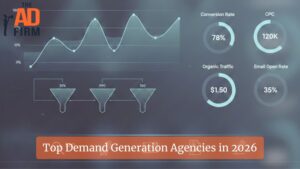Local SEO is about much more than climbing to the top of search results. What really matters is how often people take action, whether that’s calling your business, asking for directions, or clicking through to your website. These are the signals that show your marketing is driving real customers, not just digital visibility.
By learning how to track these actions, local businesses can make smarter decisions about where to focus their time and budget. Partnering with experts in local SEO services can also help you understand which efforts are creating measurable results and which ones need adjustment.
Google offers built-in tracking tools that make it easy to monitor calls, map interactions, and visits, giving you a clear view of how people engage with your business.
Why Tracking SEO Metrics Matters
Tracking SEO metrics isn’t just about seeing how many people find you online; it’s about understanding which actions prove real engagement. These points show why measurement is essential for every local business:
- Measure meaningful customer actions: The most valuable metrics come from what people do after discovering your business, such as calling, asking for directions, or visiting your website. These reveal true customer intent, not just traffic volume.
- Turn visibility into engagement: Appearing in search results is only step one; tracking post-search behavior shows whether users are actually interacting with your business. This helps distinguish awareness from action.
- Identify what drives real-world results: Monitoring these signals connects your online marketing to offline outcomes. It highlights which keywords, listings, or campaigns drive direct visits or calls.
- Spot performance gaps early: Analyzing engagement data helps you identify where users drop off, such as unreturned calls or unvisited listings, so you can fix weak points before they cost you leads.
- Base decisions on verified data: Working with an experienced SEO company ensures your tracking is set up correctly, so your strategy evolves from proven insights rather than assumptions or incomplete analytics.
Key Metrics to Track for Local SEO Success
Local SEO is not just about appearing in search results; it’s about understanding how those results drive real-world interactions. These metrics show you the difference between being visible online and actually bringing customers closer to choosing your business.
Elevate Your Market Presence with The Ad Firm
- SEO: Boost your search engine visibility and supercharge your sales figures with strategic SEO.
- PPC: Target and capture your ideal customers through highly optimized PPC campaigns.
- Social Media: Engage effectively with your audience and build brand loyalty through targeted social media strategies.
Tracking Calls from Your Google Business Profile
Phone calls are among the most direct ways for customers to connect with your business. Monitoring this activity provides insight into how many people are ready to talk immediately after finding you in search results.
- Check call button activity in GBP Insights: Google Business Profile tracks the number of times users tap the “Call” button. This number represents people who decided your listing was worth contacting without hesitation. Unlike general traffic data, this metric shows action that directly ties to potential sales. Even small increases in call clicks can represent real revenue opportunities.
- Enable call history for deeper insights: Turning it on lets you see missed and completed calls in GBP. This feature provides an additional layer of data, showing whether calls were answered, how long they lasted, and whether follow-ups are needed. Businesses can utilize this information to enhance customer service and prevent missed opportunities. It turns raw call numbers into a record of actual conversations.
- Spot seasonal call trends: Calls often rise and fall depending on the time of year, sales cycles, or events. By comparing activity across different months, you can identify when customer demand is highest. This helps you adjust marketing campaigns or staff availability to match the uptick. A digital marketing agency might use this data to recommend running more ads during peak call periods.
- Measure quality as well as volume: Not every call is equal, so businesses should track the types of inquiries they receive to ensure a more effective response. Are people calling about prices, hours, or making actual bookings? Understanding the reason for calls shows whether SEO is attracting the right audience. It’s a way to ensure that phone activity leads to meaningful conversions rather than casual curiosity.
Measuring Map Clicks and Direction Requests
When someone clicks for directions, it signals a strong intent to visit your location. Tracking this data reveals your business’s foot traffic potential, showing how often online searches turn into people preparing to walk through your doors.
- Review direction request data in GBP: GBP Insights shows how often users click to get directions to your business. Each request is a strong signal that someone is considering a physical visit, making it more powerful than just an impression or a view. This data connects online presence with offline results in a measurable way. Businesses can treat these clicks as potential customers already halfway through the door.
- Analyze where requests come from: GBP often provides general starting points for identifying the origin of direction requests. If you notice many customers requesting directions from a specific area, it suggests untapped demand. This insight allows you to target those areas with localized promotions or service updates. It can even guide decisions about delivery zones or future branch locations.
- Understand peak times for visits: Direction requests often follow patterns based on time of day or week. For example, a restaurant may see spikes on Friday evenings, while a gym might notice more requests early in the morning. Tracking these patterns helps you plan operating hours, staffing levels, and promotions more effectively. It ensures that you are prepared when customers are most likely to show up.
- Connect direction data to sales opportunities: Frequent direction requests but low in-store purchases could signal a conversion issue. Maybe customers arrive but don’t find what they expected, or perhaps parking is limited. By pairing this data with feedback, you can identify and resolve barriers that prevent people from completing their visits. Over time, this strengthens the link between online interest and in-person sales.
Monitoring Website Visits from GBP and Local Search
Website visits reflect how many customers move beyond your local profile to learn more about your business. Tracking these clicks helps you see how well your online presence converts curiosity into deeper engagement.
Advance Your Digital Reach with The Ad Firm
- Local SEO: Dominate your local market and attract more customers with targeted local SEO strategies.
- PPC: Use precise PPC management to draw high-quality traffic and boost your leads effectively.
- Content Marketing: Create and distribute valuable, relevant content that captivates your audience and builds authority.
- Track clicks from GBP Insights: Google Business Profile records how many users click through to your website from your listing. These visitors are actively choosing to learn more about your products or services. Unlike direction requests, this action shows digital engagement that can lead to inquiries or online purchases. Each click represents a deeper level of digital engagement, visitors exploring your services, reading content, or comparing options before they commit.
- Use UTM parameters for GA4 tracking: By adding UTM tags to your GBP website link, you can see exactly where traffic is coming from in Google Analytics. This prevents confusion about whether visitors arrived through GBP, ads, or other sources. Clean data makes it easier to evaluate which local SEO tactics are actually working. Without UTMs, your numbers may be combined, making them less useful for informed decision-making.
- Measure engagement after the click: Don’t just count website visits, check what those visitors do once they arrive. Do they stay on the site, browse service pages, or abandon quickly? Tools like GA4 enable you to measure bounce rate, time spent, and completed actions, such as form fills. This indicates whether your website content aligns with the expectations established by your local profile.
- Identify gaps between local and site performance: If your GBP generates clicks but your site doesn’t convert, the problem may be poor page design or unclear messaging. Monitoring post-click behavior reveals these weaknesses. For example, if many visitors exit from your pricing page, it may signal that the information is incomplete or confusing. Fixing this ensures a smoother path from search to conversion.
Using Search Queries to Understand Customer Intent
Search queries give you a window into the exact words customers type before finding your business. This data, available from tools like Google Business Profile Insights and Google Search Console, shows what people want most and helps you refine your SEO strategy using both local and organic insights.
- Review the terms customers use: GBP Insights lists the top queries that lead to your profile. These include service types, product categories, or city-based searches. Knowing these terms shows whether your business is appearing for the right kinds of searches. It ensures your visibility aligns with what customers are actively looking for.
- Spot gaps in customer demand: Sometimes, queries reveal interest in services or features your profile doesn’t currently highlight. For example, if many people search for “24-hour repair” but your listing doesn’t mention after-hours service, you may be missing out on potential customers. This gap becomes an opportunity to update your content or add details. It helps you capture more relevant traffic without extra advertising.
- Guide content and page optimization: Search data isn’t just for your profile; it can inform updates to your website and marketing materials. If people consistently search for “affordable” or “same-day,” those terms can be naturally woven into service descriptions. Aligning your content with these queries makes your site more relevant in search results. Over time, this strategy builds stronger authority for your business.
- Stay updated as customer habits change: search trends shift in response to seasonal changes, economic fluctuations, or the emergence of new competitors. Regularly monitoring queries keeps your business aware of these shifts. By adjusting content and services to match, you can remain competitive in real-time. Ignoring this data risks falling behind when customer expectations evolve.
Read Also: Geo-Targeted Blog Posts That Rank: How to Create Content Google Loves in Each City
Boost Your Business Growth with The Ad Firm
- PPC: Optimize your ad spends with our tailored PPC campaigns that promise higher conversions.
- Web Development: Develop a robust, scalable website optimized for user experience and conversions.
- Email Marketing: Engage your audience with personalized email marketing strategies designed for maximum impact.
Understanding User Intent in Local SEO
When people search online, they aren’t just typing words into Google; they’re expressing a goal. That goal, known as search intent, is what the person is actually looking for. For local businesses, understanding intent is crucial because it indicates whether someone is merely browsing or is ready to take immediate action.
- Informational intent: These searches are about learning, not making a purchase. Someone might search “how to repair a leaky faucet” or “best time to plant tomatoes.” For a business, these queries don’t always lead to a sale, but they provide chances to publish helpful content. For example, a plumbing company could post blogs answering these questions to build trust.
- Navigational intent: In this case, the user already has a specific brand or business in mind. Examples include “Starbucks Main Street” or “Walmart near me.” If your business name comes up in these searches, it means customers already recognize your brand. Optimizing your profile ensures they find the correct location quickly and easily.
- Commercial investigation: These searches happen when people are comparing options. A user might look up “best Italian restaurant in downtown” or “affordable gyms near me.” At this stage, details like reviews, photos, and menu highlights help sway decisions. Businesses that present complete and attractive listings often win these comparisons.
- Transactional intent: This intent is focused on action. A search like “book dentist appointment online” or “order flowers same day” shows the user is ready to buy or book now. If your website and profile make it simple to complete the action, you’ll capture more of these conversions. This is where tactics used in ecommerce SEO also apply to local businesses: removing friction makes sales happen faster.
- Local intent: Perhaps the most critical for local SEO, these searches include terms like “near me” or specific city names. Someone searching “pizza near me” is not just curious; they are probably about to make a purchase. By optimizing for these searches, businesses meet customers at the exact moment they’re ready to visit.
Ready to Turn Metrics Into Local Growth?
Visibility in local search is only the beginning; real results come when customers take action. At The Ad Firm, we specialize in local SEO services, combining in-depth metrics tracking with proven strategies to drive calls, map clicks, and visit intent for your business.
Strengthen Your Online Authority with The Ad Firm
- SEO: Build a formidable online presence with SEO strategies designed for maximum impact.
- Web Design: Create a website that not only looks great but also performs well across all devices.
- Digital PR: Manage your online reputation and enhance visibility with strategic digital public relations.
Whether you need help integrating GBP insights, interpreting data from GA4 and Search Console, or optimizing your site for local conversions, our team is here to transform analytics into revenue.
Contact The Ad Firm today and let us help you build a metrics-driven local strategy that turns visits into customers.





